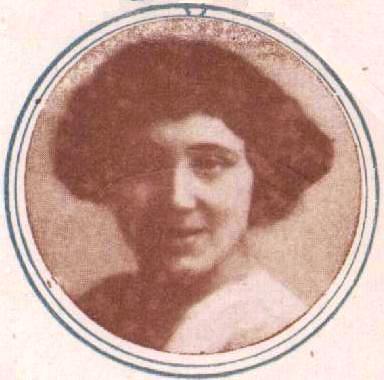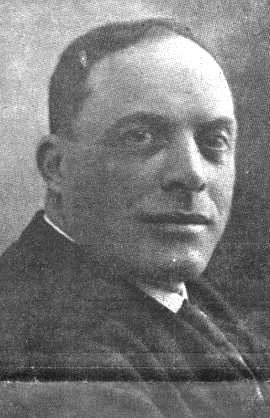RUGGERO LEONCAVALLO "PAGLIACCI"
La voce del Padrone, incisione acustica
Canio (Pagliaccio) - Luigi Bolis
Nedda (Colombina) - Anita Conti
Tonio (Taddeo) - Giuseppe Montanelli
Beppe (Arlecchino) - Augusto Prat
Silvio - Ernesto Badini
CORO E ORCHESTRA DEL TEATRO ALLA SCALA DI MILANO
Direttore - Carlo Sabajno
Milano, 1917

Luigi Bolis
Anita Conti
Giuseppe Montanelli
Ruggero
Leoncavallo's short verismo masterpiece "Pagliacci" is one of the
most frequently recorded pieces in the history of operatic music. Its
discography, comprising in itself more than 130 recordings, starts with the first
complete version of the opera dating back to 1908, recorded by HMV in Milan
with the starry cast from the La Scala theatre under the supervision of the
composer, followed by the 1909 German-language Odeon version from the Königliche Hofoper Berlin.
The third one comes the present 1917 HMV incision. Such and early and the third
world recording of such a popular opera must seem a valuable treasure to lovers
of historic recordings. But is it really so?
A bit of introduction first. These "Pagliacci", just like the 1908 version, were recorded by HMV with the orchestra of the Teatro alla Scala under the baton of maestro Sabajno and are included in the extensive acoustic series of complete opera recordings made in Milan from 1908 to 1921. What strikes a potential listener when he/she sees the cast lists of these incisions is the obscurity of most of the names. Almost none of the singers in this set were ever famous. Take, for example. Giorgina Ermolli, the Santuzza in the 1915 "Cavalleria rusticana", or Margherita Bevignani, the Violetta in "La traviata" of the same year. The 1917 "Pagliacci" are no exception. Almost all the principal roles are performed by forgotten singers who managed their careers in small opera houses and never appeared at the Teatro alla Scala whose orchestra they are singing to. Quite interesting, isn't it? Let us try to say what their singing is all about.
The role of Canio was given to Luigi Bolis (18..-1947), an Italian tenor of modest reputation whose uncle was a prominent tenor of the same name (also Luigi Bolis, who died in 1905). Junior Bolis studied in Milan and made his debut in the operetta, and later during his career combined it with singing in operas. His appearances were focused in provincial theatres, and only twice appeared at the Teatro Costanzi in Rome and the Teatro Regio di Torino in "La bohème", "Mefistofele" and "Rigoletto". His interpretation of Canio in the 1917 recording, however, definitely cannot be called provincial. His voice, a purely dramatic tenor, has an individually "ringing" timbre, perfectly suitable for highly emotional verismo roles. It is technically balanced, expressive and versatile. The "Vesti la giubba" is sung passionately and tragically, while "No, Pagliaccio non son" sounds expressively militant and pushy.
The Nedda is the forgotten Italian soprano Anita Conti (1889-1975). This performer, as I have found out, sang a wide repertoire of dramatic and lyric soprano roles in the Italian province from 1910 till 1938, and once, in 1920, appeared at the Teatro La Fenice in Venice in “Loreley” and “Tosca”. She obviously left no other recordings but these "Pagliacci". Judging from her only incision, she was generally a proper interpreter, using her well-cultured voice with style and dramatic understanding. However, there is something in her soprano that makes her interpretation of Nedda no more than acceptable and sometimes even turns annoying. While her upper notes sound polished and crystal-clear, her bass register is insipidly bleating and tremulous, which gravely spoils her otherwise well-sung balatella (“Qual fiamma… Stridono lassù”) and the duets with Tonio and Silvio, as well as all the other "binding" scenes.
The next goes the Tonio, Giuseppe Montanelli (1879-1963), a little-known singer who, unlike Bolis and Conti, apart from small provincial venues appeared in 1916 at the Teatro alla Scala in "Aida" and "Isabeau". An old-school bartione, he possesses (like Ettore Bastiniani) a high-timbred voice with a slight vibrato in the upper register. He is brilliantly passionate in the Prologue scene and maliciously sarcastic as the vindictive hunchback.
Ernesto Badini (1876-1937), the most prominent singer on this recording, with his exceptional baritone is an ardent and charming Silvio, equally good as in the 1908 version. However, Augusto Prat (dates unknown) who sings Beppe performs Harlequin’s serenade in a languid and chaotic way, and his final C sounds uglily tense.
Maestro Carlo
Sabajno leads the orchestra of the Teatro alla Scala di Milano professionally
and with exquisite taste, just like he does in the 1908 version. The horns in
the Prologue sound heart-breakingly tragic and the rich strings in the
Intermezzo are sublimely emotional. The Scala chorus is sometimes too quiet,
being “oversounded” by the orchestra, but it still (as always) performs at a
dignified level.
To sum up, the
third complete world edition of Ruggero Leoncavallo’s “Pagliacci” presents to
its listener a generally good and professional performance, which might even
seem more attractive because of its rarity and the obscure names of the singers.
Despite some disadvantages and its obvious inferiority (especially in the role
of Nedda) to the starry 1908 “Pagliacci” (with the brilliant names of Antonio
Paoli, Giuseppina Huguet and Francesco Cigada), but is quite listeanable and
can even be enjoyed.


Комментариев нет:
Отправить комментарий